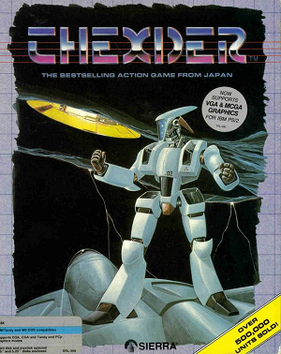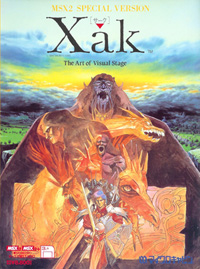
Hentai is a style of Japanese pornographic anime and manga. A loanword from Japanese, the original term ) does not describe a genre of media, but rather an abnormal sexual desire or act, as an abbreviation of hentai seiyoku, and is also used to refer to persons who hold or do such desires and acts, often translated to English as "pervert". In addition to anime and manga, hentai works exist in a variety of media, including artwork and video games.

In Japan, pornography has unique characteristics that readily distinguish it from western pornography. Pornographic films are known as "adult videos" (AV) in Japan, so Japanese adult videos (JAV) refers to the Japanese pornographic film industry. Animated films are referred to as hentai in English, but in Japan the terms "adult anime" and "erotic animation" are used. In addition to pornographic videos and magazines featuring live actors, there are now categories of pornographic manga and anime, and pornographic computer games.
Enix Corporation was a Japanese multimedia publisher who handled and oversaw video games, manga, guidebooks, and merchandise. It was founded in 1975 by Yasuhiro Fukushima as Eidansha Boshu Service Center, initially as a tabloid publisher and later attempting to branch into real estate management. Beginning in 1982, Enix began publishing video games. Three notable early collaborators were designers Yuji Horii and Koichi Nakamura, and composer Koichi Sugiyama. Horii, Nakamura and Sugiyama would all work on the 1986 role playing video game (RPG) Dragon Quest for the Family Computer; one of the earliest successful RPGs for consoles, it spawned a franchise of the same name which remains Enix's best-known product.

In Japanese popular culture, lolicon is a genre of fictional media which focuses on young girl characters, particularly in a sexually suggestive or erotic manner. The term, a portmanteau of the English words "Lolita" and "complex", also refers to desire and affection for such characters, and fans of such characters and works. Associated with unrealistic and stylized imagery within manga, anime, and video games, lolicon in otaku culture is generally understood as distinct from desires for realistic depictions of girls, or real girls as such, and is associated with the concept of moe, or feelings of affection and love for fictional characters as such.
An eroge is a Japanese genre of erotic video game. The term encompasses a wide variety of Japanese games containing erotic content across multiple genres. The first eroge were created in the 1980s, and many well-known companies in the Japanese gaming industry originally produced and distributed them. Some eroge are primarily focused on erotic content, while others, such as Key's Kanon, only contain occasional scenes in an otherwise non-erotic work. Games in the latter category are often re-released with sexual content removed for general audiences. Throughout its history, the genre has faced controversy for its use of explicit sexual content, and as a result has been banned from several console platforms.
A bishōjo game or gal game is "a type of Japanese video game centered on interactions with attractive girls".

The PC-8800 series, commonly shortened to PC-88, are a brand of Zilog Z80-based 8-bit home computers released by Nippon Electric Company (NEC) in 1981 and primarily sold in Japan.
Video games featuring sexual content has been found since the early days of the industry and can be found on most platforms and can be of any video game genre.

Thexder is a run and gun video game from Game Arts, originally released for the NEC PC-8801 in 1985. It was ported to many systems, including the Famicom.

Dragon Buster is a platform, action role-playing dungeon crawl game developed by Namco and released in 1984. It runs on Namco Pac-Land hardware, modified to support vertical scrolling. In Japan, the game was ported to the Family Computer (Famicom), MSX, and X68000; the latter version was later released for the Virtual Console in the same region on November 18, 2008. Dragon Buster has been ported for the PSP and is available as part of Namco Museum Battle Collection. It was followed by a Japan-only Famicom sequel, Dragon Buster II: Yami no Fūin, and was later followed by the PlayStation game Dragon Valor, which was both a remake and sequel.

Jesus is a graphic adventure game developed and published by Enix. It was first released in 1987 on the PC-8801, FM-77AV, X1, and the MSX2 and was later ported to the Famicom in 1989 as Jesus: Kyōfu no Bio Monster. A sequel, Jesus II, was released on the PC-8801, PC-9801, and X68000 in 1991.

Code Age is a 2005 multimedia franchise developed and published by Square Enix. It was created by Yusuke Naora and split between three projects; the manga Code Age Archives, the mobile role-playing video game Code Age Brawls, and the PlayStation 2 action role-playing game Code Age Commanders. Code Age uses a science fiction setting on the inner surface of a hollow world similar to a Dyson sphere. The narratives revolve around an apocalyptic threat to civilization, with the protagonists gaining powers from absorbing monsters dubbed the Otellos.

Xak: The Art of Visual Stage (サーク) is the first game in the fantasy role-playing video game series Xak developed and published by Micro Cabin. It was originally released for the NEC PC-8801 computer system, with subsequent versions being developed for the NEC PC-9801, Sharp X68000, MSX2, PC-Engine, Super Famicom, and mobile phones. The first four versions were re-released for Windows on online store Project EGG. An English translation of Xak: The Art of Visual Stage was also released in 2007 on the now-defunct retro gaming service WOOMB.net, and became available on Project EGG.
Cruise Chaser Blassty is a science fiction role-playing video game developed by Square for various Japanese computers, including the NEC PC-8801, PC-9801, and Sharp X1. The game featured mecha originally designed by Mika Akitaka and musical contributions by Nobuo Uematsu, being the very first video game he wrote music for. The game had an unusual battle system, which involved the player controlling a customizable mecha robot from a first-person view. It followed a group of young people from Earth caught up in a war between a solar-system spanning government and a group of rebels. After release, the game's story was adapted to a manga and serialized, then released as a pair of standalone books. The manga received a sequel, though the game itself did not.

Door Door is a single-screen puzzle-platform game developed by Enix and published in Japan in 1983. Originally released for the NEC PC-8801, it was ported to other platforms, including the Family Computer. Controlling a small character named Chun, the player is tasked with completing each stage by trapping different kinds of aliens behind sliding doors. Chun can jump over the aliens and climb ladders, and must also avoid obstacles such as large nails and bombs.
An otomegame is a story-based video game that is targeted towards women. Generally one of the goals, besides the main story goal, is to develop a romantic relationship between the female main player character and one of the usually male, secondary lead characters.

The Earth Fighter Rayieza is a role-playing video game developed and published by Enix. It was originally published in 1985 for the PC-8801, FM-7, X1, and MSX personal computer systems. The game was ported to the Famicom on December 15, 1987 by Nintendo under the title Ginga no Sannin (銀河の三人). The programming was done by Pax Softnica.

Sleeping Dogs is a 2012 action-adventure video game developed by United Front Games and published by Square Enix. It was released for PlayStation 3, Xbox 360 and Windows. Set in contemporary Hong Kong, the story follows martial artist and undercover police officer Wei Shen who infiltrates the Sun On Yee Triad organization. Gameplay focuses on Wei Shen's martial arts moves, fighting, shooting and parkour abilities, and on gadgets that can be used for combat and exploration. Players must complete missions to unlock content and continue the story, but they may instead freely roam the game's open world environment and engage in both legal and criminal activities. The latter may incite a police response, the intensity of which is controlled by a "heat" system. Actions such as fighting, driving and racing grant Shen statistical rewards and earn the player achievements.

The Idolmaster Cinderella Girls is a Japanese free-to-play simulation video game co-developed by Cygames and Bandai Namco Studios for the Mobage social network platform for mobile phones. It was first released on November 28, 2011, for feature phones, and compatibility was extended to iOS and Android devices on December 16, 2011. The game is based on The Idolmaster franchise, and features a cast of new idol characters. In September 2015, a music video game developed by Cygames titled The Idolmaster Cinderella Girls: Starlight Stage was released on the Google Play Store and Apple Store in Japan. The original game ended service on March 30, 2023, and was succeeded by its spinoff game and adaptations.












